Hachee (Dutch Beef & Onion Stew)
This post may contain affiliate links. See my disclosure policy.
Hachee is a traditional beef and onion stew found in virtually every Dutch home. It’s a delicious comfort dish to enjoy during the cold winter months. The long, slow cooking time produce super tender meat and a rich sauce with wonderful depth of flavor. This authentic hachee recipe is one the whole family will love!
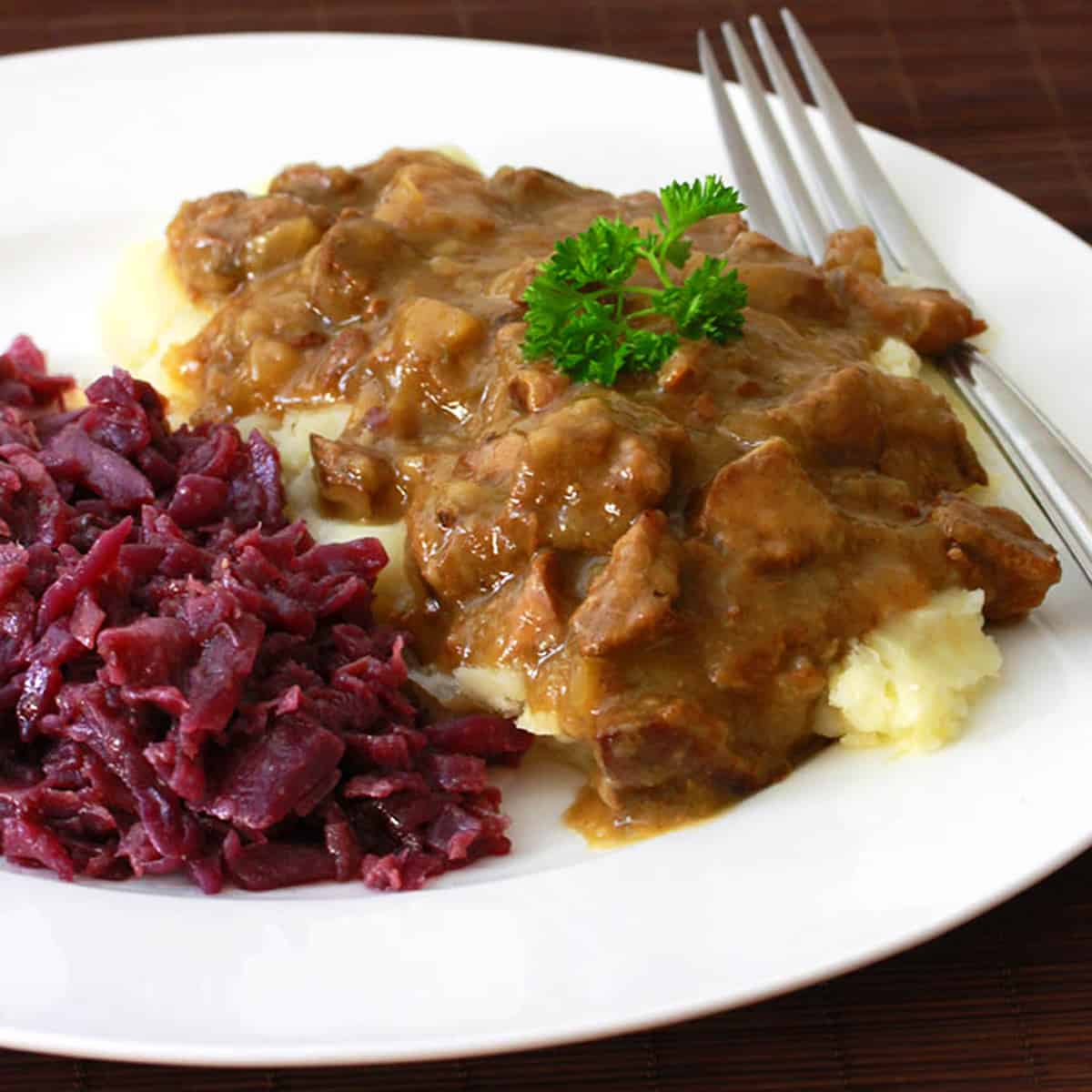
What is Hachee?
The word hachee has its origins in the French hacher, meaning “to chop” and Hachee is sometimes referred to as a “hash.” Hachee has been around since the middle ages and like many of the traditional dishes of Europe that we know and love today, it was originally a peasant dish, created as a means of using up leftover meat and vegetables. The vinegar was used to tenderize tough pieces of meat, much like the French used wine in Coq Au Vin). Less expensive vegetables likes onions were used in generous amounts. A long cooking process further ensured the meat would be tender. Hachee remains a popular and much-loved dish in the Netherlands. So much so that you can find it ready-made in grocery stores. But nothing beats homemade, and your patience in the long, slow cooking process will yield results that will make your taste buds swoon.
Traditional Seasonings in Hachee
The flavor profile of Hachee is significantly different from the traditional beef stews we know here in the U.S.. Hachee uses equal parts of beef and onion and the onions are caramelized. The featured flavors in this stew are cloves, juniper berries, black peppercorns, bay leaves and vinegar – all of which come together to provide a wonderful depth of flavor that is both rich and comforting. The flavor of Hachee shares similarities with German Sauerbraten.

I first made this recipe over 10 years ago when my husband’s family came for a visit. My father-in-law had lived in the Netherlands for a while as a young adult and fell in love with the country, its people, and its food. Many of the dishes he enjoyed there over 40 years ago he hadn’t had since, and he has often mentioned longing to enjoy them again. So I wanted to surprise him with a traditional Dutch meal. I narrowed it down to three options: Boerenkool Stampot, Hutspot, and Hachee. I decided on Hachee. It’s a little more interesting, plus you can’t find the smoked Dutch sausages (rookworst) here that are traditionally eaten with the other two dishes. And it also gave me the excuse to finally make the braised red cabbage with it that many of my readers had been requesting – a side dish that is equally popular in Germany where it is known as Rotkohl.
As my father-in-law sat down to dinner he instantly recognized the dish. “This is the dish I had almost every night during my first two months in the Netherlands!” It was the first time he had had it in over 40 years and he savored every bit. We all did.

Hachee Recipe
Let’s get started!
Cube the beef and pat it dry with a paper towel – this will ensure that it browns well. Sprinkle with a little salt and pepper.
Brown the beef in a Dutch oven. Brown the cubes on all sides. Brown in batches so as not to overcrowd the beef – that will prevent it from browning properly. Remove the beef and set aside, leaving the burnt bits on the bottom of the pan – those will provide a lot of flavor to the stew.

Add some more butter and caramelize the onions until golden brown. Add the flour and stir to combine.
Add the beef to the onions.
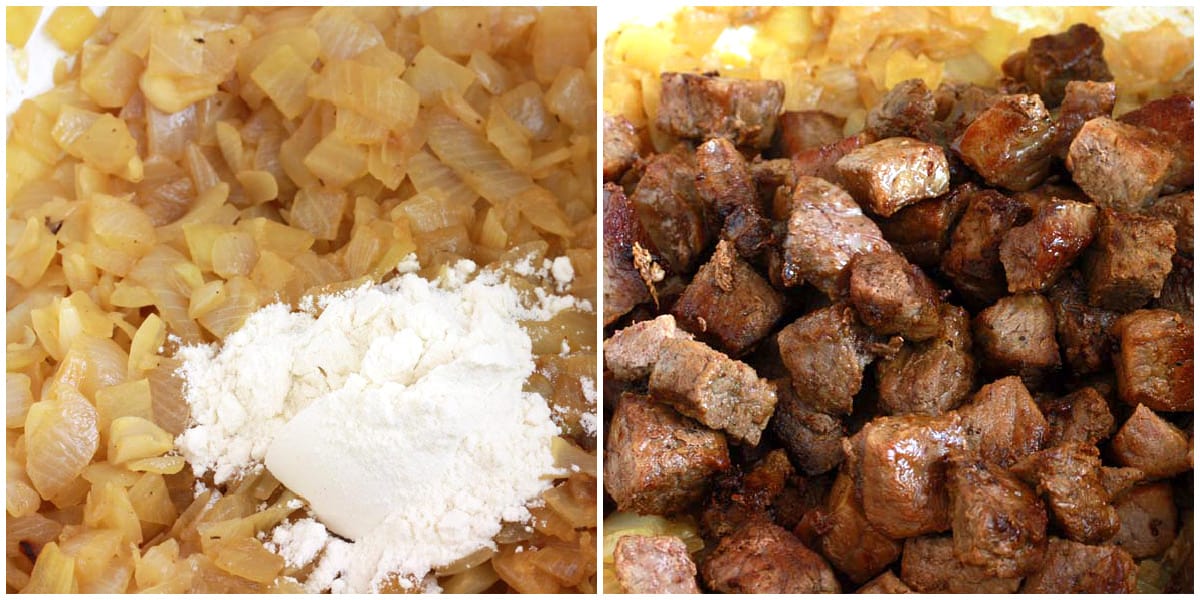
Add the beef broth and the seasonings. Bring to a boil, reduce the heat to low, cover and simmer for 2 1/2 hours. Uncover and simmer for another 30 minutes to help thicken the sauce. If it needs further thickening, make a slurry with equal parts of flour and water and stir it into the stew, stirring constantly to prevent lumping. Return to a simmer until the stew is thickened.
Add salt, pepper and more red wine vinegar to taste.
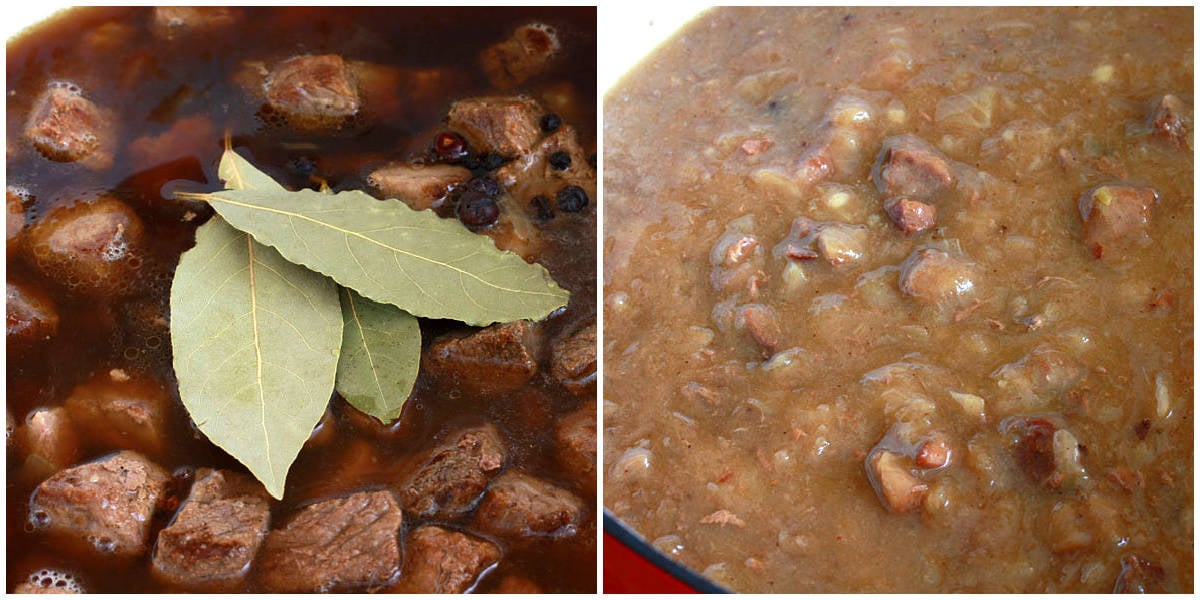
Hachee is traditionally served with aardappelen (potatoes) and rode kool met appeltjes, which is braised red cabbage with apples, also known as Rotkohl in German. A serving of applesauce is also common.
Eet smakelijk!
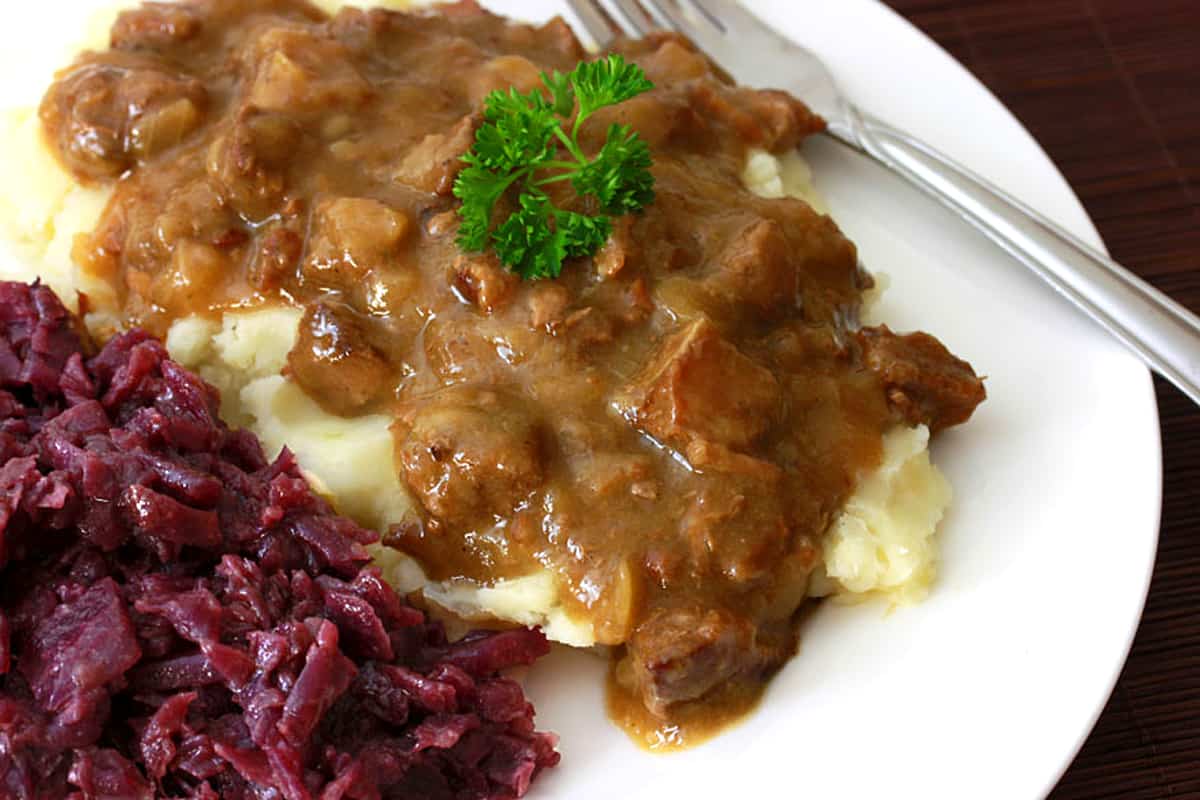
For more delicious beef stews from around the world be sure to try my:
- Swedish Kalops
- Hungarian Goulash
- Guinness Stew
- Pörkölt
- Beef Bourguignon
- Sega Wat
- Old Fashioned Beef Stew
- African Peanut Stew
- Szegedin Goulash
Save This Recipe
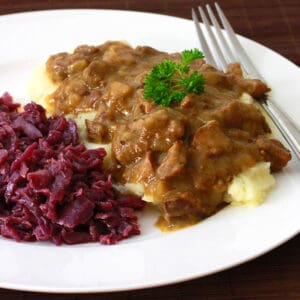
Hachee (Dutch Beef & Onion Stew)
Ingredients
- 2 pounds stewing beef (e.g. chuck) , cubed in 1/2 in. pieces, blotted dry with paper towel, lightly seasoned with salt and pepper
- 3 tablespoons butter
- 2 pounds yellow onions , about 4 large, finely chopped
- 1/4 cup all-purpose flour
- 4 cups good quality beef broth or stock
- 3 large bay leaves
- 4 cloves
- 4 juniper berries
- 10 black peppercorns
- 2 tablespoons red wine vinegar
- 3/4 teaspoon salt
- 1/4 teaspoon freshly ground black pepper
Instructions
- Melt the butter in a Dutch oven over medium-high heat. Brown the beef on all sides, working in batches so as not to overcrowd. Transfer to a plate and set aside. Leave the browned bits in the pan (important for flavor).Add the onions and some more butter if needed and cook until caramelized, about 25 minutes. Add the flour and stir until combined. Add the beef to the onions, stir to combine, and cover with the beef stock just until covered. Add the seasonings and red wine vinegar, stir to combine.Increase the heat and bring the stew to a boil. Reduce the heat to low, cover, and simmer for 2 1/2 hours. Uncover and simmer for another 30 minutes to further thicken the stew. Add salt, pepper and more red wine vinegar to taste. Discard the juniper berries, cloves, and bay leaves. Leave in or discard the peppercorns.Serve with mashed potatoes and braised red cabbage.
Nutrition
Originally published on The Daring Gourmet January 6, 2014



















My Mum always used the basic Hachee recipe from the 1964 “Magriet Kook Boek”, with a couple of variations. I still use the same recipe and always serve it with Stampot. The spices in this recipe are identical to yours but instead of using juniper berries, we add 1 finely diced Granny Smith apple (a tart apple in Australia), 1 tsp of sugar and we use white vinegar instead of the red wine vinegar. I will certainly try your version next winter.
Thanks for sharing, Theresia. The addition of the apple sounds lovely. Yes, give the juniper berries a try next time, they really add a wonderful flavor element to the hachee. Juniper berries are a common ingredient in many traditional Dutch and German recipes.
Hi Kimberly, I was brought up in the Netherlands and we always had Hachee with Hutspot (leftovers with rice).
if you wanted to combine the 2 traditional Dutch dishes next time your father in law comes over it is well worth a try.
Thanks for the tip, I’ll keep that in mind!
The traditional dish suggested it designed to use left overs yet all of the recipes suggest using fresh mat and onions. I agree the dish is an excellent meal and may be combined with a lot of variables to complete it. Carmelized turnip is one of my favourites.
Thanks so much for providing the recipe for Hachee like my mom used to make! My mom never had the patience to teach me any of her Dutch cooking and 2 of my 3 brothers have been missing her cooking since she passed 6 years ago! They are going to be so excited! Thanks so much!
Thank you, Carole, I’m really excited that you’ll be able to take your family down memory lane – what a special meal that will be!
@Grietje Cinnamon and cardamom are not spices used in hachee. The sugar, yes. Maybe nutmeg though I personally never use that. The cilantro, ginger and anise really made me raise my eyebrows. I’ve never heard of it. Never seen it used in any hachee recipe. I don’t use it and neither did my mom.
A lot of people do like to use ginger bread in the hachee, I’ve never done so either. There are also a lot of different versions of hachee. There is no ‘absolute’. This is definately a good hachee recipe, though I will admit I did miss the teaspoon of sugar. And I never use juniper berries.
Though you are right about certain things, you are not right in claiming this is not hachee.
Any replacement for Juniper berries ? I don’t seem to find it here in the middle east.
Hi Aishah, they have a very distinct taste and there aren’t any adequate substitutes for them. I just did an online search and several sources say you can substitute 1 teaspoon of gin for every two berries, but I’ve never tried that and am not sure how it would taste.
This is not hachee, this is the recipe for ‘Stoofvlees’.
Hachee will most often also contain cinnamon, cardamom, nutmeg, and sugar. (and sometimes cilantro, ginger, anise)
To make this proces easier we tend to put a piece of gingerbread in it, since it already has those spices in it, and the bread replaces the need of flour.
Hachee is a stew heavily influenced by the VOC, due to the accesabillity to asian spices.
So don’t be suprised if you come over here and get a bowl at someone house, that it will be much sweeter then you expected :)
Hi Grietje, I think you’re confusing these dishes. I’m familiar with Stoofvlees (aka, carbonade flamande) – it’s a Belgian stew made with beer and is very different. I’m also familiar with different versions of Hachee and while I have seen some instances of cardamom being used, those recipes have been more modern. I have never heard of anise, ginger or cilantro being used in this. Perhaps you’re referring to more contemporary versions of Hachee? Hachee is a peasant dish dating back to the Middle Ages and cardamom, a luxury spice, would have been virtually inaccessible to the poor. Again, perhaps more contemporary versions have put an Asian spin on it, but this recipe is for a very traditional Hachee.
What a mouthwatering hash! Looks darn good…
Thanks, Sylvie, it’s super good! The spices in it give it such a great flavor.